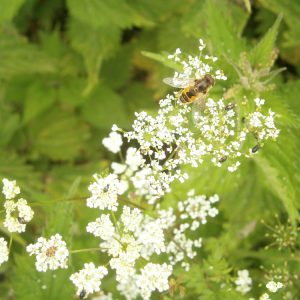June has arrived and with it warm sunshine. Combined with the inch of rain we had here towards the end of May there is a great green growing. I return from a walk waist high in cow parsley and knee high in grasses. I stood for some time listening to the turtle dove – its call a slow purr that gives a sense of drowsiness and contentment. I last saw a pair in my garden in 2013 and that territory now seems to be vacated so I walk up to the village where they still return to a four acre field tumbled down to scrub.
Turtle doves are migratory returning here each summer to breed. They like tall trees and weedy ground and their diet is mostly fumitory, black medick, red and white clover, common vetch, birds foot trefoil and redshank. All of those grow in my garden which has a tendency to be wild!
By June many of our resident birds are keeping a low profile, busy nesting and feeding young. Usually their absence is less obvious as the skies are full of swifts and swallows. But not this year. A pair of swallows returned to the barn but there are only four swifts here. And still no house martins. The skies might be brilliant blue but they are empty.

Instead I take solace from the butterflies. It has been a good year for the Orange Tip, which has been a regular visitor, feeding on garlic mustard and lady’s smock. I have also seen an early influx of Painted Ladies, a few Holly Blue, Peacock, Red Admiral, Comma and yesterday the first Speckled Wood. Some of the butterflies are resident but others migrate, most notably the Painted Ladies which arrive from Morocco – it seems an amazing journey for such a delicate looking, tissue paper thing.
With longer days it is time to sit and ponder and watch nature at its most abundant. I have been absorbed by the new pond, which is still finding its balance, the plants still settling and growing. Peering into the murky depths I watch the manic behaviour of water boatman as they rest for a few seconds upside down under the skin of the water and then row frantically across the pond to a new position. More elegant are the diving beetles which surface for a bubble of air and descend again. The least attractive is a small pale grub-like wriggling creature with a long spiny tail. It is a rat tailed maggot – yes even its name is unattractive – but it is the larva of the hoverfly which is an important pollinator. Everything has its place and we are too often drawn only to the charismatic wildlife.

One thing I am trying, this first week of June, is to keep a nature journal so I was encouraged to find it is Nature Journaling Week – which has lots of ideas and inspiration.
The 21st of June is the summer solstice – the longest day with the sun rising earliest and setting latest – a great time to get to know moths, dragonflies, crickets, grasshoppers, beetles and all our other amazing minibeasts!
And start a journal.
Melinda Appleby June 2021
